
All Solutions
Page 246: Getting Started
Here we have next:
$$
begin{align*}
x^2-3x-10&=x^2+4x+4-7x-14\&=(x+2)^2-7(x+2)\&=(x+2)(x+2-7)\&=(x+2)(x-5)
end{align*}
$$
#### (b)
$$
begin{align*}
3x^2+12x-15&=3(x^2+4x-5)\&=3(x^2+4x+4-9)\&=3((x+2)^2-9)\&=3((x+2)-3)((x+2)+3)\&=3(x-1)(x+5)
end{align*}
$$
#### (c)
$$
begin{align*}
16x^2-49=(4x-7)(4x+7)
end{align*}
$$
#### (d)
$$
9x^2-12x+4=(3x-2)^2
$$
#### (e)
By solving this quadriatic equation where unknown is $a$, we have:
$$
3a^2+a-30=(a-3)(a+dfrac{10}{3})
$$
#### (f)
By solving this quadriatic equation where unknown is $x$, we have:
$$
6x^2-5xy-21y^2=(x-dfrac{7}{3}y)(x+dfrac{3}{2}y)
$$
$$
dfrac{12-8s}{4}=dfrac{4(3-2s)}{4}=3-s
$$
#### (b)
$dfrac{6m^2n^4}{18m^3n}=dfrac{n^3}{3m}$, $m,nne0$
#### (c)
$dfrac{9x^3-12x^2-3x}{3x}=dfrac{3x(3x^2-4x-1)}{3x}=3x^2-4x-1$, $xne0$
#### (d)
$dfrac{25x-10}{5(5x-2)^2}=dfrac{5(5x-2)}{5(5x-2)^2}=dfrac{1}{5x-2}$, $xnedfrac{2}{5}$
#### (e)
$dfrac{x^2+3x+8}{9-x^2}=dfrac{(x-3)(x+6)}{(3-x)(3+x)}=-dfrac{(3-x)(x+6)}{(3-x)(3+x)}=-dfrac{x+6}{x+3}$, $xnepm3$
#### (f)
$dfrac{a^2+4ab-5b^2}{2a^2+7ab-15b^2}=dfrac{(a-b)(a+5b)}{(a-dfrac{3}{2}b)(a+5b)}=dfrac{a-b}{a-dfrac{3}{2}b}$, $anedfrac{3}{2}b$
$$
dfrac{3}{5}timesdfrac{7}{9}=dfrac{7}{15}
$$
#### (b)
$dfrac{2x}{5}divdfrac{x^2}{15}=dfrac{2x}{5}timesdfrac{15}{x^2}=dfrac{6}{x}$, $xne0$
#### (c)
$$
begin{align*}
dfrac{x^2-4}{x-3}divdfrac{x+2}{12-4x}&=dfrac{x^2-4}{x-3}timesdfrac{12-4x}{x+2}\&=dfrac{(x-2)(x+2)}{x-3}timesdfrac{4(3-x)}{x+2}\&=-4(x-2), xne3,-2
end{align*}
$$
#### (d)
$dfrac{x^3+4x^2}{x^2-1}timesdfrac{x^2-5x+6}{x^2-3x}=dfrac{x^2(x+4)}{(x-1)(x+1)}timesdfrac{(x-2)(x-3)}{x(x-3)}=dfrac{x(x+4)(x-2)}{(x-1)(x+1)}$
$$
xnepm1,0,3
$$
$$
dfrac{2}{3}+dfrac{6}{7}=dfrac{2cdot7+6cdot7}{21}=dfrac{56}{21}
$$
#### (b)
$$
dfrac{3x}{4}+dfrac{5x}{6}=dfrac{3cdot3x+2cdot5x}{12}=dfrac{19x}{12}
$$
#### (c)
$dfrac{1}{x}+dfrac{4}{x^2}=dfrac{x+4}{x^2}$, $xne0$
#### (d)
$dfrac{5}{x-3}-dfrac{2}{x}=dfrac{5x-2(x-3)}{x(x-3)}=dfrac{5x-2x+6}{x(x-3)}=dfrac{3x+6}{x(x-3)}=dfrac{3(x+2)}{x(x-3)}$, $xne0,3$
#### (e)
$dfrac{2}{x-5}+dfrac{y}{x^2-25}=dfrac{2}{x-5}+dfrac{y}{(x-5)(x+5)}=dfrac{2(x-5)+y}{(x-5)(x+5)}$, $xnepm5$
#### (f)
$dfrac{6}{a^2-9a+20}-dfrac{8}{a^2-2a-15}=dfrac{6}{(x-5)(x-4)}-dfrac{8}{(x-6)(x+2)}=dfrac{6(x-6)(x+2)-8(x-5)(x-4)}{(x-4)(x-5)(x-6)(x+2)}$,
$xne-2,4,5,6$
$dfrac{5x}{8}=dfrac{15}{4} /cdot8$
$5x=15cdot2=30$
$x=dfrac{30}{5}=6$
$textbf{Check:}$
$$
dfrac{5cdot6}{8}=dfrac{30}{8}=dfrac{15}{4}
$$
#### (b)
$dfrac{x}{4}+dfrac{1}{3}=dfrac{5}{6}$
$dfrac{3x+4}{12}=dfrac{5}{6} /cdot12$
$3x+4=10$
$3x=10-4=6$
$x=dfrac{6}{3}=2$
$textbf{Check:}$
$$
dfrac{2}{4}+dfrac{1}{3}=dfrac{1}{2}+dfrac{1}{3}=dfrac{3+2}{6}=dfrac{5}{6}
$$
$dfrac{4x}{5}-dfrac{3x}{10}=dfrac{3}{2} /cdot10$
$8x-3x=15$
$5x=15$
$x=dfrac{15}{5}=3$
$textbf{Check:}$
$$
dfrac{4cdot3}{5}-dfrac{3cdot3}{10}=dfrac{12}{5}-dfrac{9}{10}=dfrac{24-9}{10}=dfrac{15}{10}=dfrac{3}{2}
$$
#### (d)
$dfrac{x+1}{2}-dfrac{2x-1}{3}=-1 /cdot6$
$3(x+1)-2(2x-1)=-6$
$3x+3-4x+2=-6$
$-x+5=-6$
$-x=-6-5=-11$
$x=11$
$textbf{Check:}$
$$
dfrac{11+1}{2}-dfrac{2cdot11-1}{3}=dfrac{12}{2}-dfrac{21}{3}=6-7=-1
$$
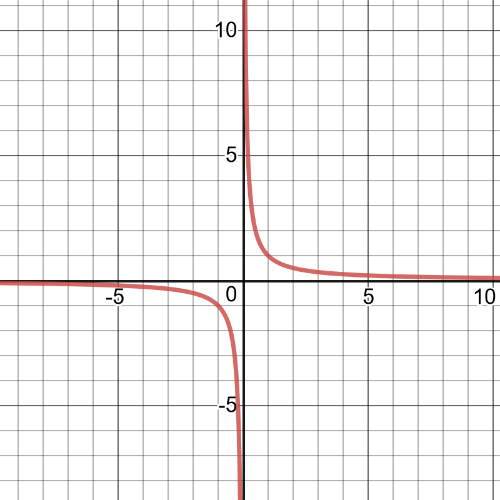
Here we have $textbf{translation}$ $3$ units to the left and on the following picture is graph of this transformed function:
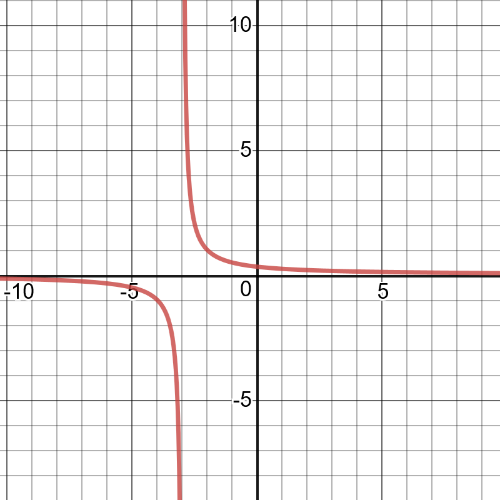
Here we have $textbf{vertical compression}$ by a factor of $2$ and $textbf{translation}$ $1$ unit to the right.On the following picture is graph of this transformed function:
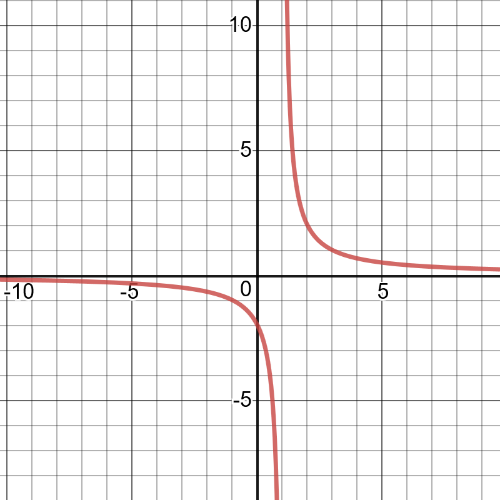
Here we have $textbf{vertical compression}$ by a factor of $-dfrac{1}{2}$ and $textbf{translation}$ $3$ units down.On the following picture is the graph of transformed function:
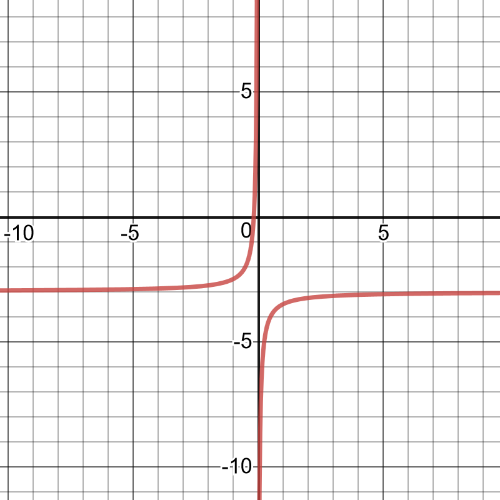
Here we have $textbf{vertical compression}$ by a factor of $2$ and $textbf{horizontal compression}$ by a factor of $-dfrac{1}{3}$, $textbf{translation}$ $2$ units to the right and $1$ unit up.On the following picture is graph oh transformed function:
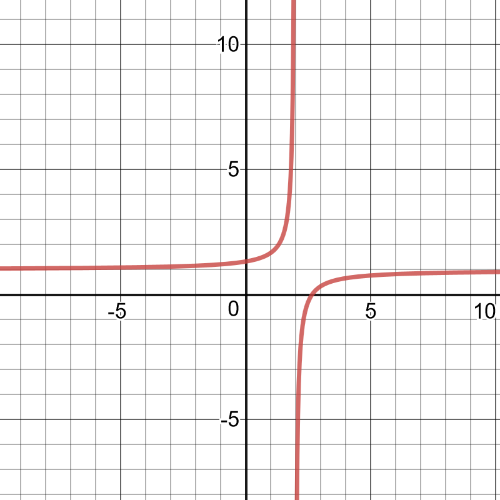
According to this, we will simplify following expression:
$$
begin{align*}
dfrac{9y^2-4}{4y-12}divdfrac{9y^2+12y+4}{18-6y}&=dfrac{9y^2-4}{4y-12}timesdfrac{18-6y}{9y^2+12y+4}\&=dfrac{(3y-2)(3y+2)}{4(y-3)}timesdfrac{6(3-y)}{(3y+2)^2}\&=-dfrac{3(3y-2)}{2(3y+2)}
end{align*}
$$

